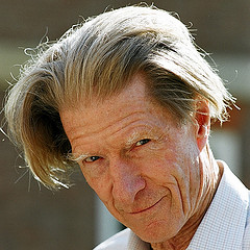Professor Sir John Gurdon

- Born
- 2 October 1933
Sir John Gurdon is widely regarded as the father of cloning. From starting out as an 'unsatisfactory' science pupil he rose to become a distinguished developmental biologist and Nobel Laureate. Gurdon's discovery of the transplantability of the cell nucleus has led to huge advances in the field of cloning, most famously Dolly the Sheep.
John Gurdon was born in 1933 in a village called Frensham, on the border between Surrey and Hampshire. In his school report from 1949, Gurdon’s biology master belittled his aspiration to become a scientist, claiming that ‘on his present showing this is quite ridiculous’. He was ranked last out of the 250 boys in his year at Eton for biology, a result which prevented him from studying any scientific discipline for the remaining three years of his school career.
However, these shortcomings did nothing to stifle Gurdon's passionate interests in plants and insects. On leaving school, he was able to secure a place at Oxford University to study zoology, which led to a PhD working in the field of developmental biology.
During his PhD, Gurdon successfully transplanted the nucleus from one cell into another, providing the first evidence that all of the cells in the body contain the same complete set of genes. The implications of this were twofold. Firstly, it meant that DNA from an adult could be placed into a nucleus of an egg to create an embryo that is the identically clone to the DNA donor. The result was Dolly the Sheep, the first mammal to be cloned from an adult.
Secondly, Gurdon's work culminated in Shinya Yamanaka’s discovery of the factors required to reprogram cells to their embryonic state in 2006. This state is called the pluripotent stem cell – a stem cell that can become almost any type of cell in the body. Implications are wide, and since Gurdon's discovery researchers have started developing ways for personalised stem cell therapy. This method uses adults cells, reverses them to induce pluripotent stem cell which can then be used to grow many types of tissues that can be transplanted back into the patient to replace cells lost due to damage or disease. Benefits of this method include the body not rejecting the transplant.
[Nuclear transfer] technology can influence models for disease and perhaps provide a route towards trying to alleviate disease
Kristin Kain, "The birth of cloning: an interview with John Gurdon." Disease Models & Mechanisms 2.1-2 (2009): 9-10.
Gurdon's discovery was a huge breakthrough, and Gurdon and Yamanaka shared the 2012 Nobel Prize in Physiology or Medicine for their contributions to the field of genetics. Following his PhD, Gurdon conducted post-doctoral work at the California Institute of Technology, before returning to Oxford as a lecturer in development. After ten years in this position, Gurdon was offered a position in the Molecular Biology Laboratory at Cambridge. After a decade at Cambridge, Gurdon was one of the founders of the Cancer Research UK and Wellcome Trust-funded centre for developmental biology in Cambridge. This centre was subsequently renamed the Gurdon Institute in 2004 as a tribute to his pioneering work.
Gurdon became a Fellow of the Royal Society in 1971 and was knighted in 1995. He continues to conduct research at the Institute, examining the ways in which cell development can malfunction and give rise to cancer.
This profile was written by a Biology: Changing the World volunteer.



